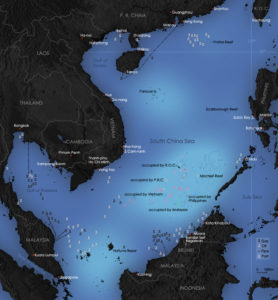 It is a dangerous time to be a fishing trawler in the South China Sea these days. Earlier this month, a Vietnamese vessel searching for oil had a rather unpleasant confrontation with a Chinese fishing boat, resulting in damage to the Vietnamese’s seismic equipment used for exploration purposes. Moreover, just this past week, the administration of Filipino President Benigno Aquino III clashed with Beijing over what it feels are exhibitions of intimidation by Chinese naval ships directed at its own oil seeking crafts.
It is a dangerous time to be a fishing trawler in the South China Sea these days. Earlier this month, a Vietnamese vessel searching for oil had a rather unpleasant confrontation with a Chinese fishing boat, resulting in damage to the Vietnamese’s seismic equipment used for exploration purposes. Moreover, just this past week, the administration of Filipino President Benigno Aquino III clashed with Beijing over what it feels are exhibitions of intimidation by Chinese naval ships directed at its own oil seeking crafts.
This territorial dispute centers on the Spratly Islands, a collection of sandbars, reefs and atolls sitting right in the center of the sea and surrounded in circinate fashion by no less than six countries – all of whom claim at least part of the archipelago chain.
A brief synopsis of the situation was provided in a recent piece at Voice of America:
In the South China Sea, the Philippines, China, Vietnam, Malaysia, Brunei and Taiwan claim all or part of the Spratlys, which are believed to hold vast oil and gas reserves. In recent months, exchanges over the claims have grown more heated, particularly between China and Vietnam, and China and the Philippines.
*
The Philippines says in recent weeks it had run-ins with China over several incidents on the South China Sea. One of the strongest allegations was that in March two Chinese patrol boats intimidated an exploration ship in waters within the Philippines Exclusive Economic Zone.
*
Philippines officials have demanded that China follow the U.N. Convention on Laws of the Sea regarding territorial claims. China, however, says that it has held sovereignty over the South China Sea for centuries.
An examination of the Law of the Sea only serves to augment the ambiguity. According to the convention, states are conferred sovereignty up to twelve nautical miles from their coast out to sea. Beyond twelve miles is considered international waters. However, the clause pertaining to exclusive economic zones (EEZs) extends a state’s baseline, or shore, to 200 miles off its coast. Furthermore, a state’s claim that the Spratlys are a part of their physical territory suggests that they can begin counting off their twelve original miles from the islands themselves, not just the territory within their sovereign borders.
The dispute has been ongoing for a number of years but has rapidly intensified in recent days, with Hanoi announcing that its navy will conduct live-fire exercises off its coast, a clear challenge to Beijing. Additionally, the disagreement presents an interesting case study for students of applied international relations. A neorealist theoretical framework suggests that each state will be concerned with relative power and gains. Due to the unknown intentions of the adversary, conflict would seem to be inevitable. On the other hand, neoliberalist thought has some merit too, as there does exists a regional organization, ASEAN, as well as many other legal international institutions (the U.N., the ICJ, etc.) which may be capable of adjudicating the dispute. A classic case of multipolar power politics, the likes of which younger students thought only existed in textbooks from a bygone era.